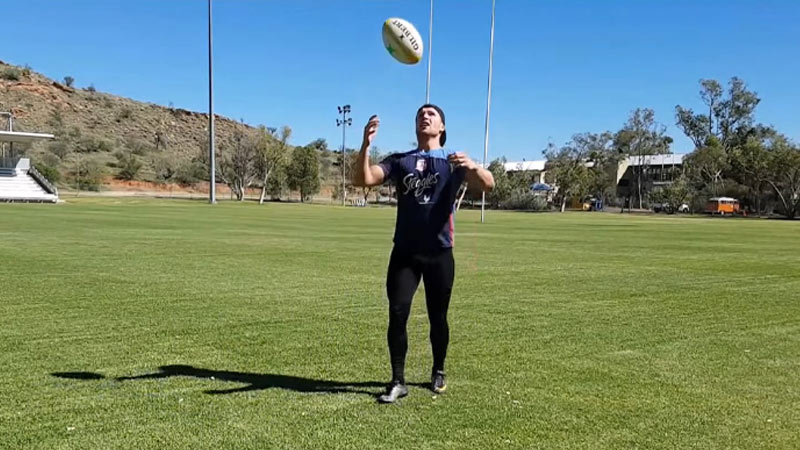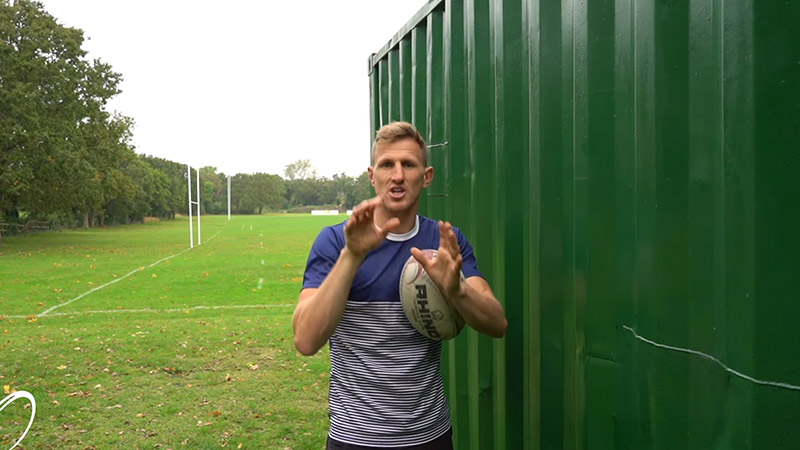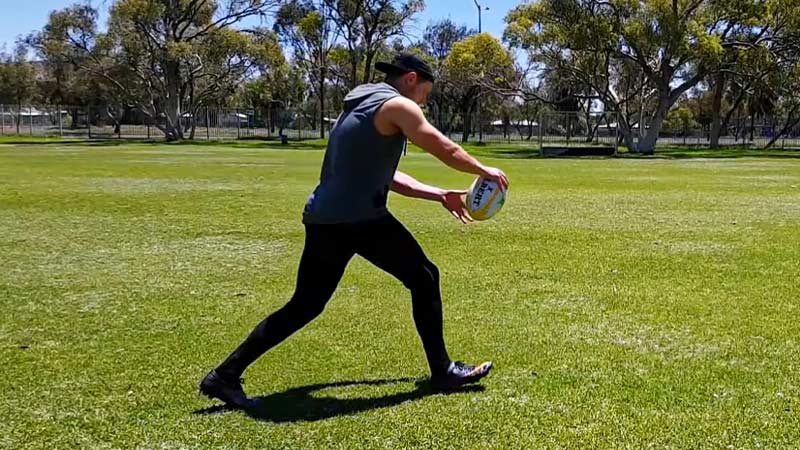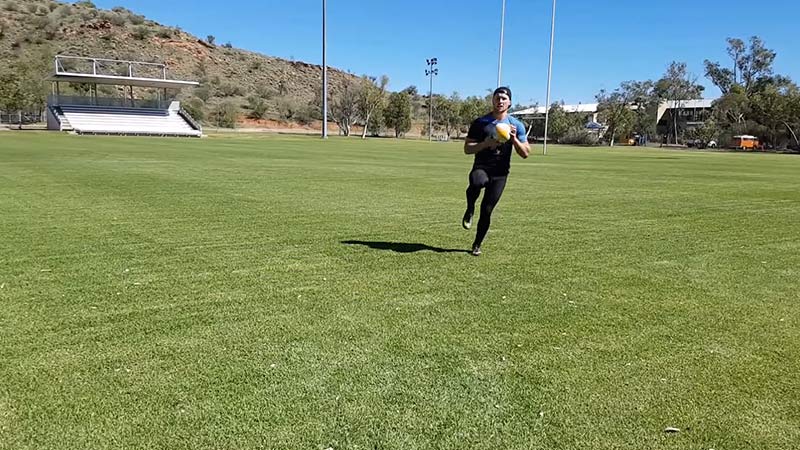In the dynamic world of rugby, where strategy, skill, and precision intertwine, the notion of catching your own punt stands as a testament to the multifaceted nature of the sport.
Rugby enthusiasts often witness players executing seemingly improbable feats on the field, and catching one’s own punt is one such display of athletic prowess. But is it a legal and strategically sound tactic? This intriguing question delves into the heart of rugby’s intricacies.
In the following discussion, we will explore the rules and nuances surrounding the ability to catch your own punt in rugby, dissecting its legality, the key aspects involved, and when precisely this daring maneuver can be deployed to seize a strategic advantage.
Can You Catch Your Own Punt in Rugby?
Yes, you can catch your own punt in rugby, provided you follow specific rules. You must be in an onside position when you kick the ball, ensuring you start behind it.
The pass must be directed backward or laterally, not forward. After the kick, opposition players can contest for the ball fairly. Timing and skill are crucial for a successful self-punt.
This tactic can create advantages by regaining possession, putting pressure on the opposition, and offering control over the game’s tempo. However, it also carries risks, such as turnovers if not executed accurately.
Proper execution and game awareness are key to catching your own punt effectively.
What Are the Key Aspects of Catching Your Own Punt in Rugby?

The art of catching your own punt in rugby involves several critical aspects that can make the difference between a successful play and a costly mistake on the field.
Here are the key aspects to consider when attempting to catch your own punt in rugby:
Onside Position
The first critical aspect is being in an onside position both when you kick the ball and when you intend to catch it. In rugby, players must start behind the ball when they make the kick.
This ensures they are not ahead of their teammates or in front of the ball, which would result in an offside offense.
Types of Kicks
Understanding the various types of kicks is fundamental. Different situations call for different kicks, such as the high kick (e.g., Garryowen or up-and-under) for contesting in the air or the chip kick for precise placement over opposition players.
Timing and Accuracy
Timing plays a pivotal role in catching your own punt. The kick must be executed with precision, placing the ball where you or your teammates have the best chance to regather it successfully.
Strategic Decision-making
The decision of when to catch your own punt is strategic. Factors like field position, score, and the positioning of the opposition must be considered.
It requires a keen understanding of the game’s dynamics and the ability to adapt to changing circumstances.
Pressure and Surprise
A well-executed self-punt can apply pressure to the opposition by disrupting their defensive structure and catching them off-guard. The element of surprise can lead to scoring opportunities.
Control and Decision-making
Regaining possession through a self-punt provides control over the ball. It enables quick decisions about the next move, such as running, passing, or setting up a structured attack, based on the situation.
Risks and Rewards
It’s essential to weigh the risks against the potential rewards. A poorly executed punt can lead to turnovers, penalties, or lost possession. Being aware of these risks is crucial for effective self-punting.
Skills Development
Mastering self-punting skills takes practice, precision, and familiarity with the sport’s rules. Players often dedicate training time to refine their kicking and catching abilities.
Communication
Effective communication with teammates is vital during self-punting situations. Clear signals and instructions can help coordinate efforts, increasing the chances of a successful outcome.
Adaptability
Rugby is dynamic, with rapidly changing field conditions. Players must be adaptable, assessing situations quickly to determine if self-punting is the most advantageous choice at a given moment.
When is the Right Time to Catch Your Own Punt in Rugby?

Determining the right time to catch your own punt in rugby is a nuanced decision that depends on various factors.
Here are scenarios and considerations to help identify the opportune moments:
Field Position
Evaluate the field position. When your team is deep in your own territory, catching your own punt can alleviate pressure and potentially advance the ball closer to the opponent’s half.
Conversely, if your team is near the opponent’s try line, you may prioritize direct scoring attempts or applying offensive pressure.
Score and Game Context
Assess the current score and game context. If your team is trailing and needs to gain ground or create scoring chances, catching your own punt can be a strategic move to shift momentum.
In contrast, if your team is leading and aims to maintain possession or manage the clock, alternative strategies might be preferable.
Opponent’s Positioning
Examine the positioning of the opposing players. If the opposition is well-organized and prepared to counter your punt, it may be riskier to catch your own kick.
Conversely, if the opposition is disorganized or out of position, it might present an opportune moment to catch the ball.
Defensive Pressure
Consider the level of defensive pressure exerted by the opposition. A well-placed self-punt can disrupt the opposition’s defensive structure, potentially leading to defensive mistakes, penalties, or turnovers.
However, it demands a high level of skill and precision.
Game Awareness
Develop a keen sense of game awareness. Recognize opportunities as they arise. For example, if you observe open space behind the defense or identify a mismatch in terms of speed or positioning, it could be the right time to execute a self-punt.
Teammate Support
Assess the support of your teammates. Are they in positions to assist in contesting for the ball or capitalizing on a successful punt? Effective communication with teammates is crucial during these situations.
Opponent’s Defensive Alignment
Observe the alignment of the opposition’s defense. If they have a strong defensive line in place, catching your own punt might be challenging. Conversely, if the opposition’s defense is scattered or ill-prepared, it may present an ideal opportunity for catching the ball.
What Are the Rules for Catching Your Own Punt in Rugby?

The rules for catching your own punt in rugby are relatively straightforward, but they are essential to ensure fair play and adherence to the laws of the game.
Here are the key rules to follow when catching your own punt in rugby:
Onside Position
To catch your own punt legally, you must be in an onside position when you kick the ball and when you regather it. This means you must start behind the ball when you make the kick.
Being onside ensures that you are not ahead of your teammates or in front of the ball, which would result in an offside offense.
No Forward Pass
When you kick the ball forward and intend to catch it yourself, the pass is considered “backward” in the context of rugby laws. Unlike in some other sports, rugby allows backward passes, but forward passes are not permitted.
Therefore, the kick must be directed backward or laterally, not forward.
Opposition Play
Once you’ve kicked the ball and it is in flight, the opposition players have the right to contest for the ball. They can jump to catch it, tackle you if you’re attempting to catch it, or compete for possession in the air, provided they do so fairly and without committing fouls.
Timing and Skill
The timing of your kick and your ability to catch the ball are crucial. The kick should be accurate and well-timed to maximize its effectiveness. Catching your own punt requires a high level of skill, including the ability to judge the ball’s trajectory and distance accurately.
Referee’s Decision
Ultimately, the referee’s judgment plays a role in determining whether a self-punt was executed within the rules. If there are concerns about the legality of the kick or the actions of players contesting for the ball, the referee will make the appropriate decisions, including awarding scrums, lineouts, or penalties as necessary.
What Are the Advantages of Catching Your Own Punt in Rugby?

Catching your own punt in rugby is a tactical maneuver that offers several strategic advantages when executed effectively:
Regaining Possession
The most apparent advantage of catching your own punt is that it allows your team to regain possession of the ball. This is especially valuable in situations where your team needs to maintain control or switch the momentum of the game.
Field Position Improvement
By catching your own punt, you have the opportunity to improve your field position. A well-placed kick and a successful catch can shift the game closer to the opponent’s territory, providing your team with a better starting point for attacking plays.
Pressure on the Opposition
An accurately executed self-punt can apply intense pressure on the opposition. It forces defenders to react quickly and disrupts their defensive formation.
This pressure can lead to defensive errors, penalties, or turnovers in favor of your team.
Control Over Game Tempo
Regaining possession through a self-punt gives your team control over the tempo of the game. You can decide whether to initiate an immediate attack, set up structured phases of play, or make another tactical decision based on the situation.
Element of Surprise
Catching your own punt can catch the opposition off-guard. They may not expect the kicker to be the one regathering the ball, leading to confusion and potential gaps in their defensive line.
Scoring Opportunities
In the right circumstances, catching your own punt can create scoring opportunities for your team. It allows you to exploit gaps or vulnerabilities in the opposition’s defense and potentially move closer to the try line.
Relief From Defensive Pressure
In defensive situations deep within your own territory, a well-placed self-caught punt can relieve pressure. It shifts the game to a more neutral or favorable position on the field, providing your team with a chance to regroup and defend more effectively.
Exploiting Open Space
Recognizing open space behind the opposing defense is a key advantage. Catching your own punt can exploit that space, forcing defenders to turn and chase, which may create opportunities for your team to launch counter-attacks.
Game Management
Catching your own punt is a valuable tool for managing the game. It can help control the pace, eat up precious time when your team is in the lead, or regain momentum when trailing.
Versatility
A player who can catch their own punt adds versatility to their team’s tactics. It introduces an additional dimension to the team’s kicking game, making it more challenging for opponents to predict and defend against your team’s strategies.
FAQs
What Is the History of Self-Punting in Rugby?
Self-punting in rugby dates back to the sport’s early days in the 19th century. It evolved from a basic skill to a strategic tactic, shaping the modern game’s dynamics.
Is it Legal to Catch Your Own Punt in Rugby?
Yes, catching your own punt in rugby is legal if you meet onside and passing rules, allowing players to kick forward and regather behind the ball.
Can the opposition charge down or block a player who is attempting to catch their own punt?
Yes, the opposition can legally attempt to charge down or block a player who is attempting to catch their own punt. However, they must do so without committing any foul play or infringing on the rules regarding dangerous tackles or challenges.
What are the risks associated with catching your own punt in rugby?
The risks of catching your own punt include potential turnovers, penalties, or lost possession if the kick is not executed accurately or if the opposition contests effectively. Additionally, there is a risk of physical contact and injury when attempting to catch the ball in the presence of opposing players.
How Can Players Improve Their Self-Punting Skills in Rugby?
Developing self-punting skills in rugby requires practice, precision, and situational awareness. Players can enhance these skills through training drills.
To Recap
The ability to catch your own punt in rugby represents a captivating facet of this exhilarating sport. Throughout this exploration, we’ve unveiled the rules and intricacies that surround this tactical maneuver, shedding light on its legality, key aspects, and strategic advantages.
Rugby’s dynamic nature encourages players to harness their skills, timing, and game awareness to determine the opportune moments for executing this daring play.
Catching your own punt, when done correctly, can be a game-changing move, disrupting the opposition’s defense, and offering vital advantages in terms of field position, possession, and pressure.
It exemplifies the balance of strategy and athleticism that makes rugby an enduring and beloved sport, showcasing the remarkable versatility of its players and the ongoing evolution of its tactics.







